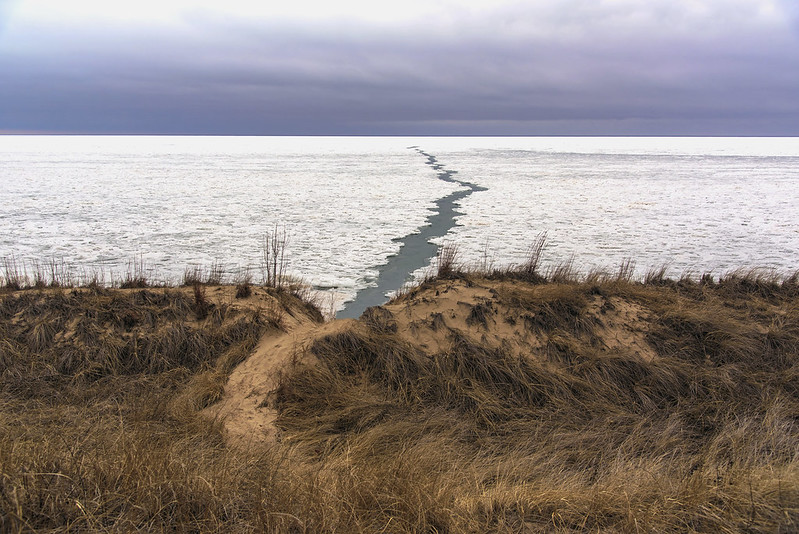 While walking along the frozen shore, we came upon a rift in the drift ice on Lake Michigan. The ice looks static, but if you visit the beach in winter, you'll realize it's almost always moving, and here is a place where forces pushed the ice apart. If you look closely, you'll notice the right side of the ice rift fits perfectly into the left side. This is sort of like a fault in geology, where the plates are pulling apart. What I found interesting is the path through the dunes to the beach seemed to lead directly to the rift, making the two appear to connect, and lead right to the horizon. Of course this is not the case, but from the top of the dune, the beach below can't be seen, and the rift looks as if it touches the dune. Over time this break in the drift ice will change. It will most likely get wider for a time, then the open spaces will ice over or fill with other drift ice pushed in by the winds over the lake.
While walking along the frozen shore, we came upon a rift in the drift ice on Lake Michigan. The ice looks static, but if you visit the beach in winter, you'll realize it's almost always moving, and here is a place where forces pushed the ice apart. If you look closely, you'll notice the right side of the ice rift fits perfectly into the left side. This is sort of like a fault in geology, where the plates are pulling apart. What I found interesting is the path through the dunes to the beach seemed to lead directly to the rift, making the two appear to connect, and lead right to the horizon. Of course this is not the case, but from the top of the dune, the beach below can't be seen, and the rift looks as if it touches the dune. Over time this break in the drift ice will change. It will most likely get wider for a time, then the open spaces will ice over or fill with other drift ice pushed in by the winds over the lake.
The Difficult Path Ahead
 While walking along the frozen shore, we came upon a rift in the drift ice on Lake Michigan. The ice looks static, but if you visit the beach in winter, you'll realize it's almost always moving, and here is a place where forces pushed the ice apart. If you look closely, you'll notice the right side of the ice rift fits perfectly into the left side. This is sort of like a fault in geology, where the plates are pulling apart. What I found interesting is the path through the dunes to the beach seemed to lead directly to the rift, making the two appear to connect, and lead right to the horizon. Of course this is not the case, but from the top of the dune, the beach below can't be seen, and the rift looks as if it touches the dune. Over time this break in the drift ice will change. It will most likely get wider for a time, then the open spaces will ice over or fill with other drift ice pushed in by the winds over the lake.
While walking along the frozen shore, we came upon a rift in the drift ice on Lake Michigan. The ice looks static, but if you visit the beach in winter, you'll realize it's almost always moving, and here is a place where forces pushed the ice apart. If you look closely, you'll notice the right side of the ice rift fits perfectly into the left side. This is sort of like a fault in geology, where the plates are pulling apart. What I found interesting is the path through the dunes to the beach seemed to lead directly to the rift, making the two appear to connect, and lead right to the horizon. Of course this is not the case, but from the top of the dune, the beach below can't be seen, and the rift looks as if it touches the dune. Over time this break in the drift ice will change. It will most likely get wider for a time, then the open spaces will ice over or fill with other drift ice pushed in by the winds over the lake.
Ice As Far As The Eye Can See
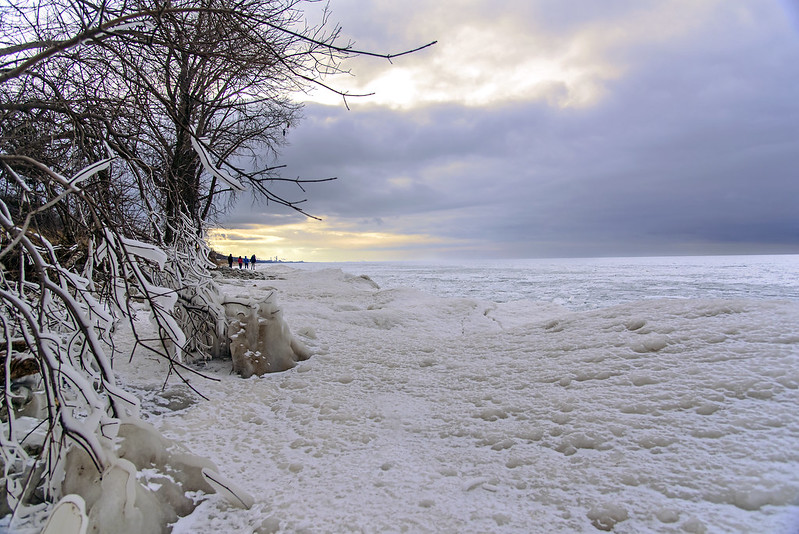 Winter changes the lakefront by the minute at times. I can't resist stopping by the lakeshore every time I pass nearby, the changes are often remarkable. Just last week, there was little to no ice past the shore- most likely pushed away by south winds. Steady winds from the north and west pushed the drift ice toward the shore where it bumps and combines with other drift ice and the shelf ice along the beach. These mounds entice visitors to check them out closer, but with the recent drizzle and warmer temperatures, the surface has become smooth ice, and very dangerous to walk on. One slip, and you'll continue to slide onto the drift ice below, and the drift ice won't hold much weight, so you'll continue into the cold lake.
Winter changes the lakefront by the minute at times. I can't resist stopping by the lakeshore every time I pass nearby, the changes are often remarkable. Just last week, there was little to no ice past the shore- most likely pushed away by south winds. Steady winds from the north and west pushed the drift ice toward the shore where it bumps and combines with other drift ice and the shelf ice along the beach. These mounds entice visitors to check them out closer, but with the recent drizzle and warmer temperatures, the surface has become smooth ice, and very dangerous to walk on. One slip, and you'll continue to slide onto the drift ice below, and the drift ice won't hold much weight, so you'll continue into the cold lake. 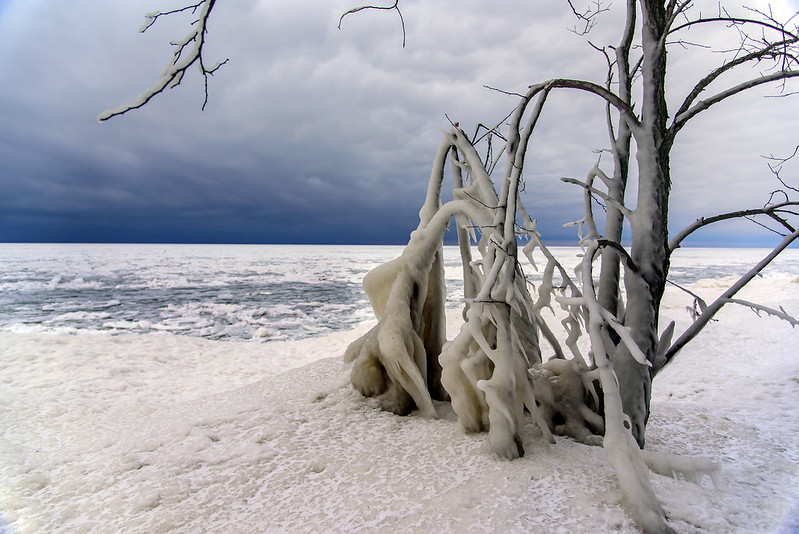 I encounter so many people walking on the ice every time I visit, or at least thinking about heading out. It really does look thick and safe enough to venture onto, but it's not. Here the high waves and winds from last weekend are evident by the ice encased tree in the foreground. This tree is about 50 feet from the water, but waves and wind drove the water this far up onto shore. We're looking at below zero temperatures tonight, and for the next three days, so we'll just have to see what the lakeshore looks like after this deep freeze.
I encounter so many people walking on the ice every time I visit, or at least thinking about heading out. It really does look thick and safe enough to venture onto, but it's not. Here the high waves and winds from last weekend are evident by the ice encased tree in the foreground. This tree is about 50 feet from the water, but waves and wind drove the water this far up onto shore. We're looking at below zero temperatures tonight, and for the next three days, so we'll just have to see what the lakeshore looks like after this deep freeze.
The Winter Sky
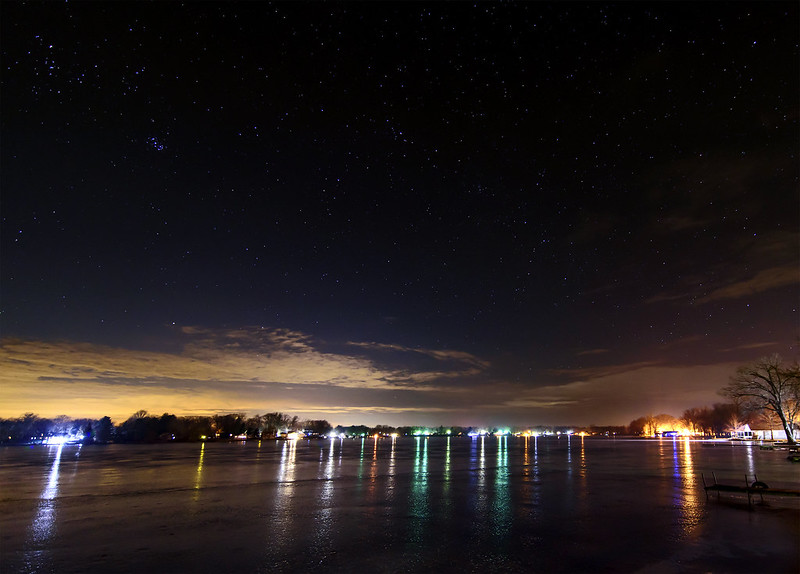 In between clear, warmer winter days, and cloudy, bitterly cold days, we set out for rural LaPorte County. The forecast called for clouds and some snow, but when we arrived, the sky was mostly clear. Once settled in, we ventured outside to check the thickness of the ice on the lake. The colorful lights from the homes across the lake reflected onto the textured ice, while the stars above shined brightly in the dark sky above. The lights from the city of LaPorte, and far away Chicago, illuminated the horizon, blocking out the stars low in the sky, but giving it an interesting transition between the light and dark. The snow arrived after 3am, but never amounted to anything. Throughout the day, flurries continued, giving distant objects a washed out appearance, but one could hardly notice the snow falling at all. Temperatures are expected to drop considerably over the next two days, back down near zero. We'll see how the ice looks after this deep freeze.
In between clear, warmer winter days, and cloudy, bitterly cold days, we set out for rural LaPorte County. The forecast called for clouds and some snow, but when we arrived, the sky was mostly clear. Once settled in, we ventured outside to check the thickness of the ice on the lake. The colorful lights from the homes across the lake reflected onto the textured ice, while the stars above shined brightly in the dark sky above. The lights from the city of LaPorte, and far away Chicago, illuminated the horizon, blocking out the stars low in the sky, but giving it an interesting transition between the light and dark. The snow arrived after 3am, but never amounted to anything. Throughout the day, flurries continued, giving distant objects a washed out appearance, but one could hardly notice the snow falling at all. Temperatures are expected to drop considerably over the next two days, back down near zero. We'll see how the ice looks after this deep freeze.
South Haven Drama
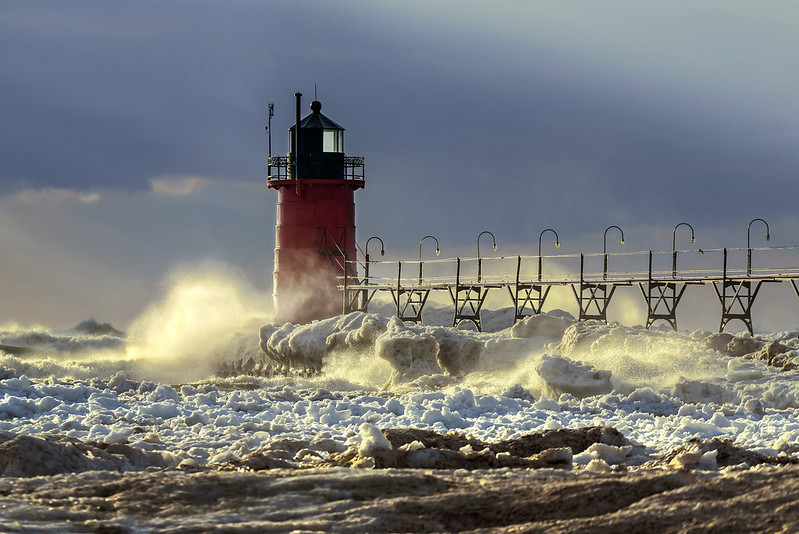 The sky and sunlight changed as fast as the winds blew on this stormy February afternoon. Wind gusts over 50 MPH created plenty of drama in the sky as well as on the water, with waves crashing into the shelf ice, shore, and pier of South Haven, Michigan. Happening in mid winter when the shore is mostly lined with mounds of shelf ice, beach erosion is actually kept to a minimum because the shore is buffered by the ice formations. In warmer periods, a good portion of the beach can erode away in just one day. As the sun poked through the heavy clouds, it highlighted the ice, water, lighthouse, and splashes on the pier, providing a great contrast against the cold snow and ice.
The sky and sunlight changed as fast as the winds blew on this stormy February afternoon. Wind gusts over 50 MPH created plenty of drama in the sky as well as on the water, with waves crashing into the shelf ice, shore, and pier of South Haven, Michigan. Happening in mid winter when the shore is mostly lined with mounds of shelf ice, beach erosion is actually kept to a minimum because the shore is buffered by the ice formations. In warmer periods, a good portion of the beach can erode away in just one day. As the sun poked through the heavy clouds, it highlighted the ice, water, lighthouse, and splashes on the pier, providing a great contrast against the cold snow and ice. 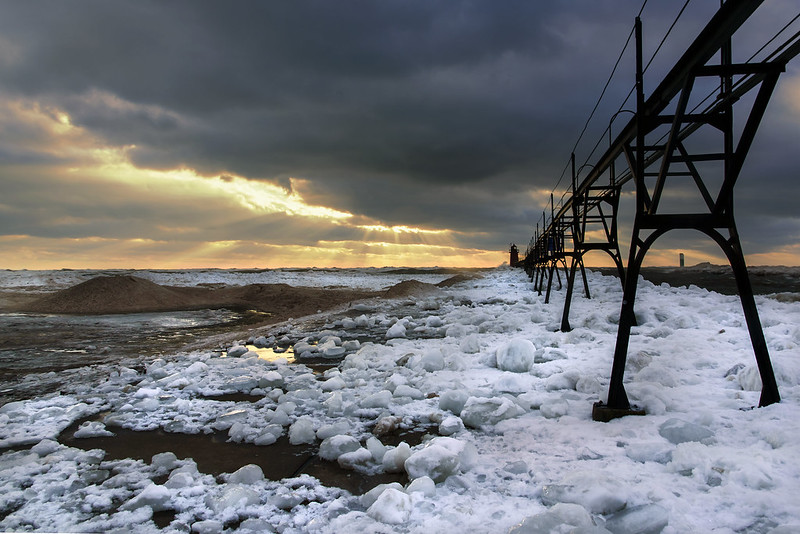 Stepping back to take in more of the pier, and using a wider lens, more of the dramatic sky could be seen behind the pier and lighthouse. The beach parking area was quite crowded with spectators out photographing the waves. Most did not venture out of their cars, but those who did, got to experience intense wind gusts exceeding 50 MPH. Sand, acting more like a light snow, was blown from the beach down the nearby streets where it collected along the curbs and in every place exposed - including my ears!
Stepping back to take in more of the pier, and using a wider lens, more of the dramatic sky could be seen behind the pier and lighthouse. The beach parking area was quite crowded with spectators out photographing the waves. Most did not venture out of their cars, but those who did, got to experience intense wind gusts exceeding 50 MPH. Sand, acting more like a light snow, was blown from the beach down the nearby streets where it collected along the curbs and in every place exposed - including my ears!
Relentless Waters
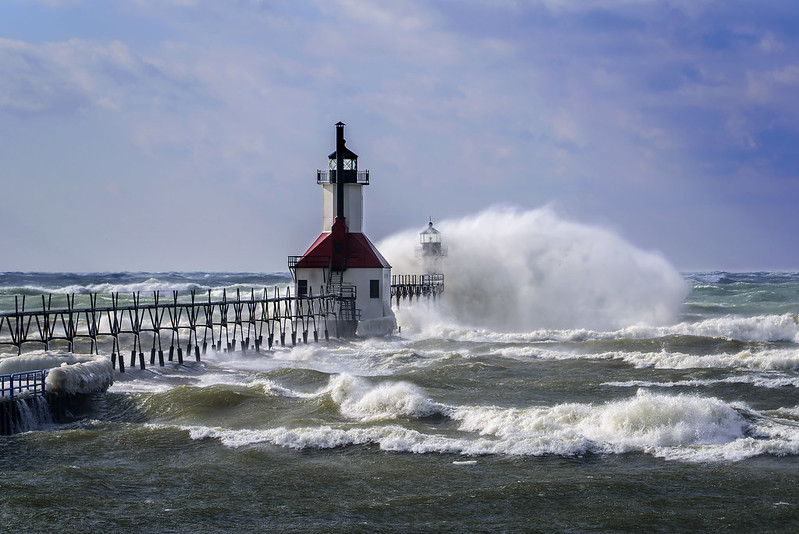 Recent high winds created plenty of drama on Lake Michigan last weekend. Large splashes could be seen from far away, as the waves crashed into the end of the pier, engulfing the outer lighthouse in a shroud of water. While I've witnessed much larger splashes against this lighthouse over the years, this day was one of the windiest I've experienced on Lake Michigan. Only two other days I've seen would rival the winds on this day.
Recent high winds created plenty of drama on Lake Michigan last weekend. Large splashes could be seen from far away, as the waves crashed into the end of the pier, engulfing the outer lighthouse in a shroud of water. While I've witnessed much larger splashes against this lighthouse over the years, this day was one of the windiest I've experienced on Lake Michigan. Only two other days I've seen would rival the winds on this day. 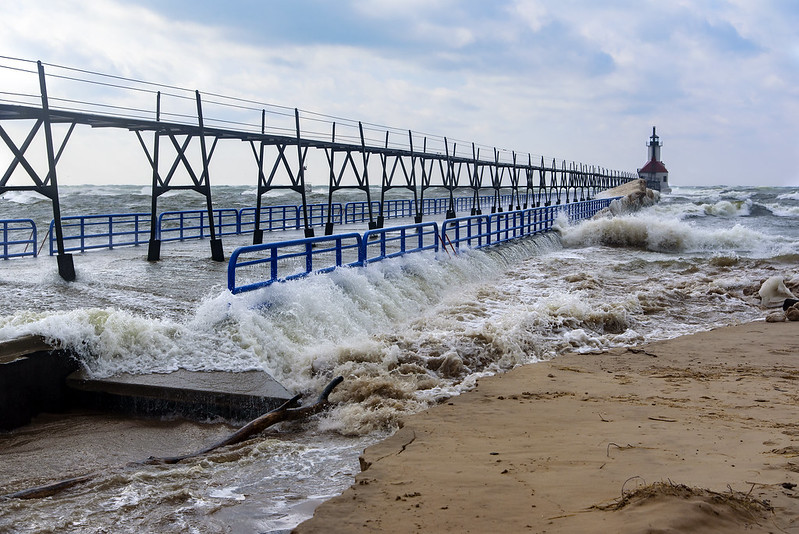 The gale blew most of the night, into the next day, churning up Lake Michigan with waves reported as high as 20 feet. This pushes the water toward the shore, and when it's this high, it pushes the water up the river, and over the pier. This relentless action has eroded the sand next to the pier, exposing utility conduits, and undercutting the concrete walkway. The couple of hours I spent on the shore were spent constantly wiping the water droplets from the camera lens - even when quite far away from the water. The rest of the night was spent cleaning sand from everything, including inside my ears. I'm sure I'll continue to find sand in every piece of gear for the next few weeks.
The gale blew most of the night, into the next day, churning up Lake Michigan with waves reported as high as 20 feet. This pushes the water toward the shore, and when it's this high, it pushes the water up the river, and over the pier. This relentless action has eroded the sand next to the pier, exposing utility conduits, and undercutting the concrete walkway. The couple of hours I spent on the shore were spent constantly wiping the water droplets from the camera lens - even when quite far away from the water. The rest of the night was spent cleaning sand from everything, including inside my ears. I'm sure I'll continue to find sand in every piece of gear for the next few weeks.
St. Joseph Gale
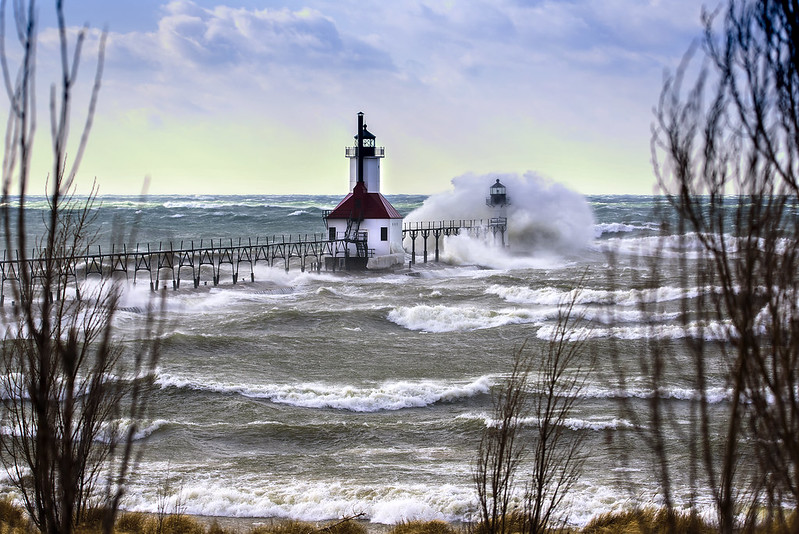 The range lights marking the entrance to the St. Joseph River at Lake Michigan take a pounding by the high waves of the lake. Gusts exceeding 50mph churned up the water and pushed it inland and over the pier, washing away quite a bit of sand in the process. A good amount of the shelf ice along the shore either melted, or was washed away by the high waves.
The range lights marking the entrance to the St. Joseph River at Lake Michigan take a pounding by the high waves of the lake. Gusts exceeding 50mph churned up the water and pushed it inland and over the pier, washing away quite a bit of sand in the process. A good amount of the shelf ice along the shore either melted, or was washed away by the high waves.  The 35 foot tall, newly restored outer lighthouse still leans a bit, but continues to withstand the winter storms so common to this area. As the waves hit the end of the pier, they create dramatic splashes that engulf the lighthouse and wash over the pier. It's this precise action that often creates the thick layers of ice seen on the lighthouse and pier. The high winds and waves brought out dozens of people eager to witness the power of the wind and water; many of whom stayed in their cars to avoid the wind, cold spray, and blowing sand.
The 35 foot tall, newly restored outer lighthouse still leans a bit, but continues to withstand the winter storms so common to this area. As the waves hit the end of the pier, they create dramatic splashes that engulf the lighthouse and wash over the pier. It's this precise action that often creates the thick layers of ice seen on the lighthouse and pier. The high winds and waves brought out dozens of people eager to witness the power of the wind and water; many of whom stayed in their cars to avoid the wind, cold spray, and blowing sand.
Winter Winds
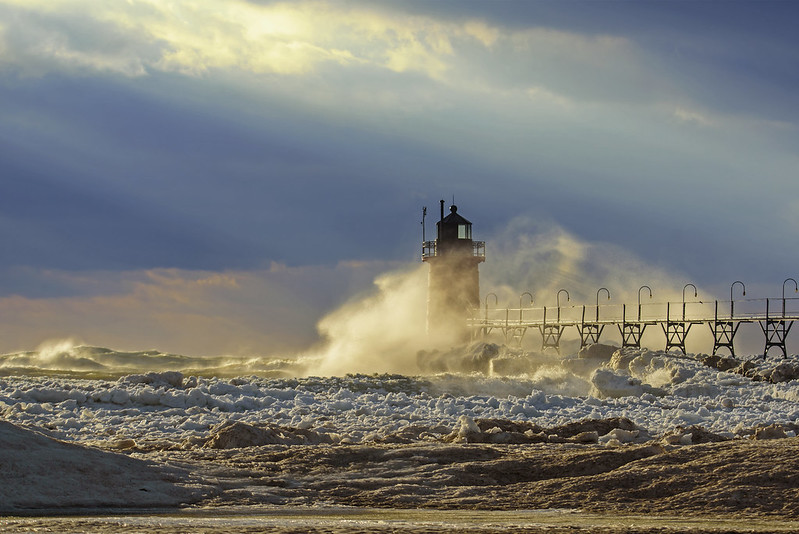 Hearing the forecast of 60 mph wind gusts, I made plans to head out to the Michigan shore of Lake Michigan - hoping for high waves. When I arrived, I was not disappointed. While I can't say this was the windiest day I've seen on the lake, this was certainly one of the most dramatic days on Lake Michigan I've experienced. South Haven, Michigan still had quite a bit of shelf ice along the shore, and even large chunks of drift ice floating in the Black River. The high waves tossed the car-sized ice chunks up over the railings of the river walk. At times, it was difficult to walk and stand still because of the winds, and the sand being kicked up into your face. As usual, if you can make it close to the water, there is no sand to blow into your face, you only need to worry about the water spray on the camera lens. Arriving around 3:00 pm local time, the sky was mostly cloudy, but as I walked the beach, the sun began to peek through the clouds and illuminate the waves and spray. The scene takes on an entirely different look as the sun goes in and out, and it becomes more difficult to photograph each time the light changes.
Hearing the forecast of 60 mph wind gusts, I made plans to head out to the Michigan shore of Lake Michigan - hoping for high waves. When I arrived, I was not disappointed. While I can't say this was the windiest day I've seen on the lake, this was certainly one of the most dramatic days on Lake Michigan I've experienced. South Haven, Michigan still had quite a bit of shelf ice along the shore, and even large chunks of drift ice floating in the Black River. The high waves tossed the car-sized ice chunks up over the railings of the river walk. At times, it was difficult to walk and stand still because of the winds, and the sand being kicked up into your face. As usual, if you can make it close to the water, there is no sand to blow into your face, you only need to worry about the water spray on the camera lens. Arriving around 3:00 pm local time, the sky was mostly cloudy, but as I walked the beach, the sun began to peek through the clouds and illuminate the waves and spray. The scene takes on an entirely different look as the sun goes in and out, and it becomes more difficult to photograph each time the light changes. 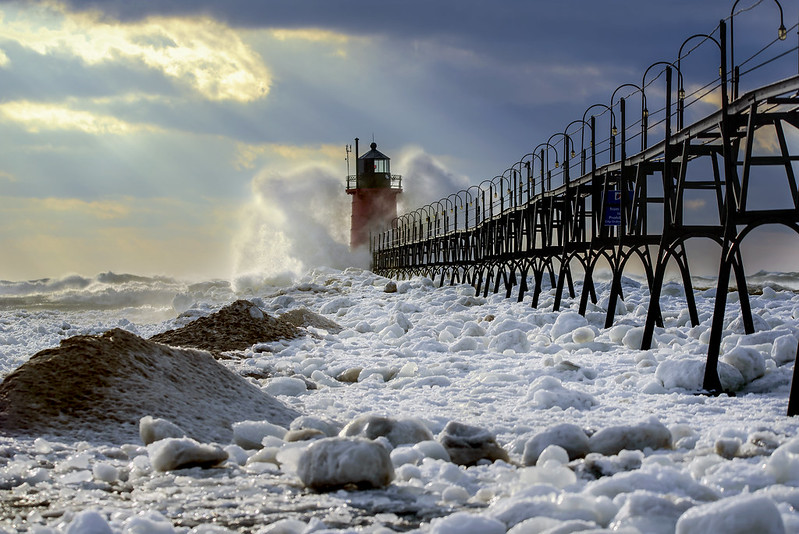 I suppose the spray will begin to freeze onto the lighthouse and catwalk surfaces if the winds continue through the night. The ice boulders have already deposited on the beach and pier, making the walk to the beginning of the pier difficult, and the walk to the end of the pier impossible - at least until the waves subside. Temperatures were in the low 30s but with the high winds, the "feel-like" temperatures were around 8 degrees. In very little time, exposed skin began to freeze, and even through gloves, my hands were numb in just ten minutes. If you've never experienced winds such as these by Lake Michigan, I encourage you to seek out days like these in the future; it's like nothing you've ever seen before.
I suppose the spray will begin to freeze onto the lighthouse and catwalk surfaces if the winds continue through the night. The ice boulders have already deposited on the beach and pier, making the walk to the beginning of the pier difficult, and the walk to the end of the pier impossible - at least until the waves subside. Temperatures were in the low 30s but with the high winds, the "feel-like" temperatures were around 8 degrees. In very little time, exposed skin began to freeze, and even through gloves, my hands were numb in just ten minutes. If you've never experienced winds such as these by Lake Michigan, I encourage you to seek out days like these in the future; it's like nothing you've ever seen before.
Snow and Shadows
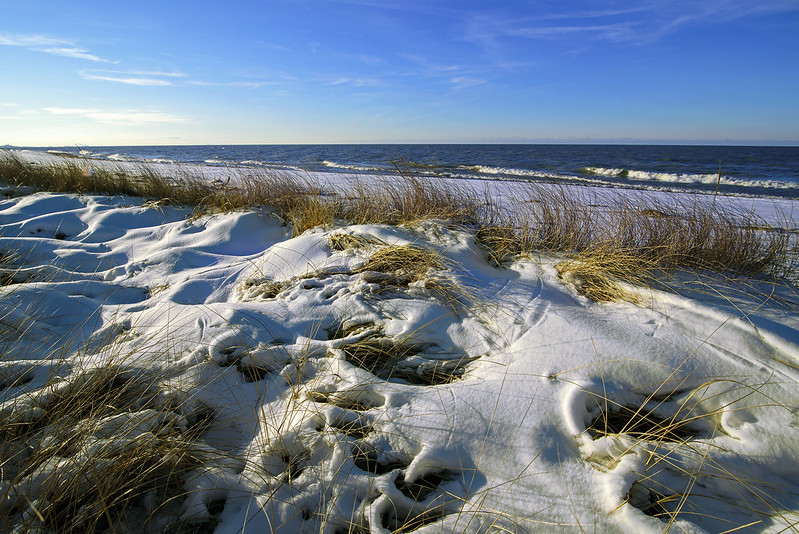 Freshly fallen snow combined with the sun shining at a low angle, highlight the subtle contours and textures of the landscape of the Indiana Dunes. Lake Michigan makes the perfect background, the blue contrasts the bright snow, but matches the colors of the shadows in the snow. Even this small amount of snow makes hiking more difficult- especially when the ground is frozen solid. The normally soft sand becomes a solid, icy surface beneath the slippery snow, making hills challenging to climb and descend.
Freshly fallen snow combined with the sun shining at a low angle, highlight the subtle contours and textures of the landscape of the Indiana Dunes. Lake Michigan makes the perfect background, the blue contrasts the bright snow, but matches the colors of the shadows in the snow. Even this small amount of snow makes hiking more difficult- especially when the ground is frozen solid. The normally soft sand becomes a solid, icy surface beneath the slippery snow, making hills challenging to climb and descend. 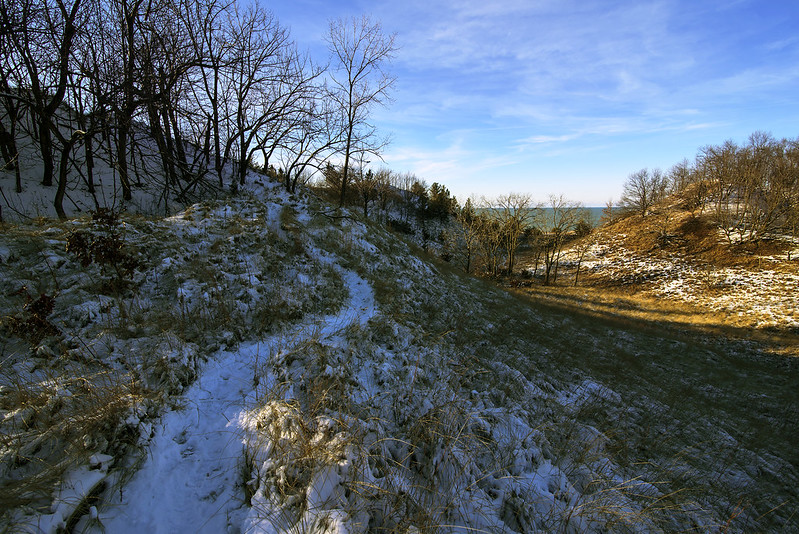 Regardless of the snow, we still kept pace and hiked a few miles though the rolling hills of the dunes. A new view greeted us around every turn, and over every dune. All the while, Lake Michigan kept us company, first next to us, then a distant object looming in the distance. We wandered in and out of sun and shadow, keeping watch on the warm tones the sun gave to the dormant grasses and trees. I certainly look forward to the spring, when the tones aren't the only things that are warm.
Regardless of the snow, we still kept pace and hiked a few miles though the rolling hills of the dunes. A new view greeted us around every turn, and over every dune. All the while, Lake Michigan kept us company, first next to us, then a distant object looming in the distance. We wandered in and out of sun and shadow, keeping watch on the warm tones the sun gave to the dormant grasses and trees. I certainly look forward to the spring, when the tones aren't the only things that are warm.
Distant Lighthouse
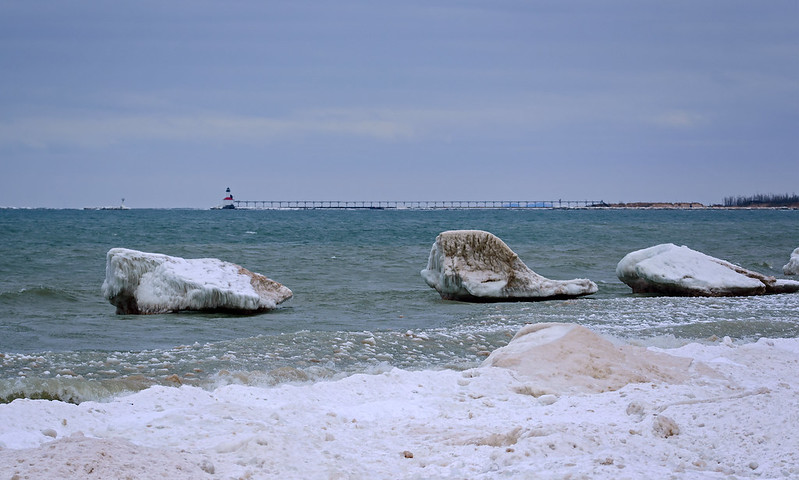 The Michigan City, Indiana East Pierhead Lighthouse seen over the shelf ice on the Lake Michigan shore. This lighthouse is seen from Central Beach, Part of the new Indiana Dunes National Park, formerly the Indiana Dunes National Lakeshore. The beach is showing signs of erosion, in fact, many of the trails on the dune ridges are long gone, they tumbled into the lake years ago. The shelf ice helps protect the dunes during the windy winter months, keeping the waves from washing away any more sand. Perhaps the park's new status will aid in beach restoration processes and these sand-starved beaches will once again become wide.
The Michigan City, Indiana East Pierhead Lighthouse seen over the shelf ice on the Lake Michigan shore. This lighthouse is seen from Central Beach, Part of the new Indiana Dunes National Park, formerly the Indiana Dunes National Lakeshore. The beach is showing signs of erosion, in fact, many of the trails on the dune ridges are long gone, they tumbled into the lake years ago. The shelf ice helps protect the dunes during the windy winter months, keeping the waves from washing away any more sand. Perhaps the park's new status will aid in beach restoration processes and these sand-starved beaches will once again become wide. 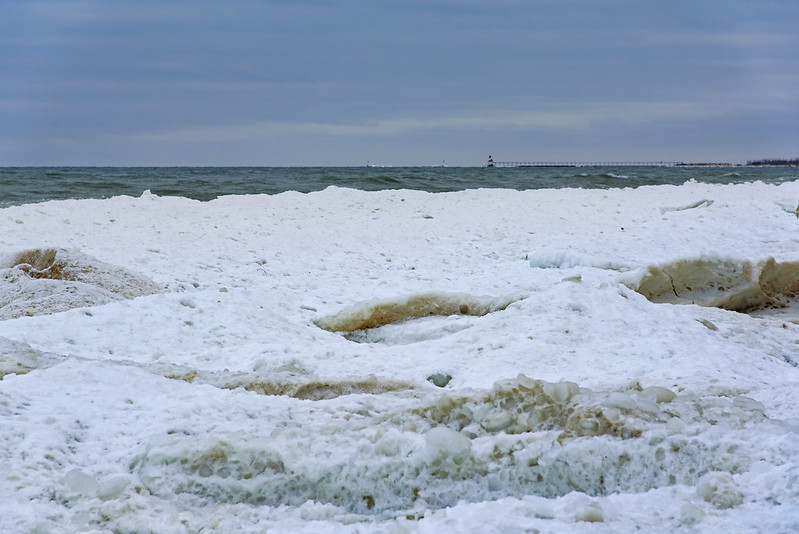 Over the past few weeks, the ice on the lake has grown and melted. The weather over the next few weeks will determine how much the shore will change during the remaining weeks of winter.
Over the past few weeks, the ice on the lake has grown and melted. The weather over the next few weeks will determine how much the shore will change during the remaining weeks of winter.
Lake Michigan Shelf Ice
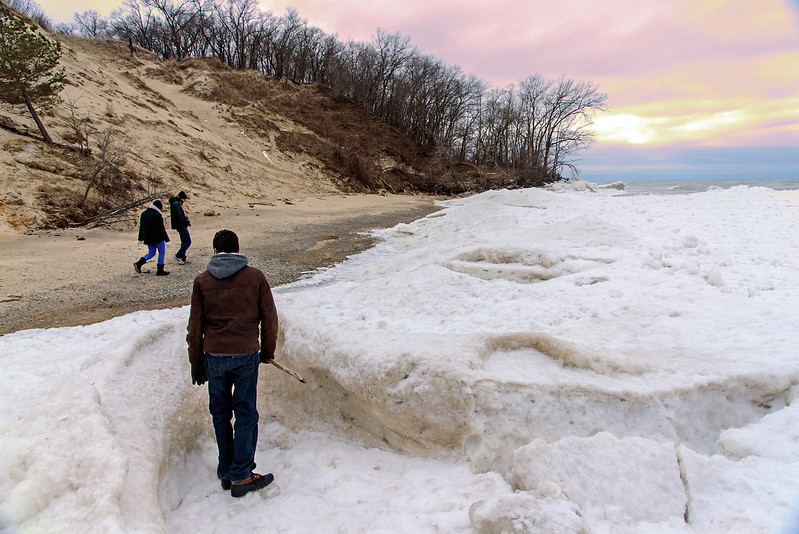 Each winter, the waves of Lake Michigan crash onto the beach and freeze into large ice mounds. Some years, these mounds can reach a height of 15 feet or more, and extend into the lake as far as the eye can see. This year, the ice isn't that tall or that wide, but it's still impressive if you walk along the shore. Walking on this is can be deadly, and should never be done. Knowing this beach very well, and being able to read the shore and ice, I can tell the first ice mounds on the beach were actually on the shore and not over water. These mounds formed early, before any shelf ice formed into the lake, so the splashing water created mounds on the sand, a few feet from the water's edge. So, where we were standing in the photo above, was on the shore, and not over the water. If you're not familiar with the beach, don't even walk near this ice, the churning water can deposit sand and stones on the ice, making it appear as if you're walking on the sand, but in fact you're walking on the ice.
Each winter, the waves of Lake Michigan crash onto the beach and freeze into large ice mounds. Some years, these mounds can reach a height of 15 feet or more, and extend into the lake as far as the eye can see. This year, the ice isn't that tall or that wide, but it's still impressive if you walk along the shore. Walking on this is can be deadly, and should never be done. Knowing this beach very well, and being able to read the shore and ice, I can tell the first ice mounds on the beach were actually on the shore and not over water. These mounds formed early, before any shelf ice formed into the lake, so the splashing water created mounds on the sand, a few feet from the water's edge. So, where we were standing in the photo above, was on the shore, and not over the water. If you're not familiar with the beach, don't even walk near this ice, the churning water can deposit sand and stones on the ice, making it appear as if you're walking on the sand, but in fact you're walking on the ice.  A close-up of one of the ice mounds gives a bit of information about how it was formed. It appears a lot like a volcano, and it's formed by similar physics. The water and ice splash up and begin to form a cone, and the cone grows in size until it becomes wider than the ice can be thrown by the water. At that time, the ice begins to build out into the lake. So these ice mounds form next to one another and extend far out into the lake. Ice and snow often cover these holes and cracks, making them difficult to see. One can easily step into them and fall through the thin ice, into the cone and into the freezing cold water below. There's really no way out.
A close-up of one of the ice mounds gives a bit of information about how it was formed. It appears a lot like a volcano, and it's formed by similar physics. The water and ice splash up and begin to form a cone, and the cone grows in size until it becomes wider than the ice can be thrown by the water. At that time, the ice begins to build out into the lake. So these ice mounds form next to one another and extend far out into the lake. Ice and snow often cover these holes and cracks, making them difficult to see. One can easily step into them and fall through the thin ice, into the cone and into the freezing cold water below. There's really no way out.  At this time of the winter, the ice only extends about 100 feet into the lake. It appears it was a bit wider a few weeks back, judging by some of the lone ice chunks standing in the water past the shelf ice. If you visit the lakeshore in winter, please remember to stay off the ice at all times. It may be 10 or 15 feet thick, but there are so many cracks and holes you don't see that lead to the frigid water below
At this time of the winter, the ice only extends about 100 feet into the lake. It appears it was a bit wider a few weeks back, judging by some of the lone ice chunks standing in the water past the shelf ice. If you visit the lakeshore in winter, please remember to stay off the ice at all times. It may be 10 or 15 feet thick, but there are so many cracks and holes you don't see that lead to the frigid water below
Indiana Dunes National PARK
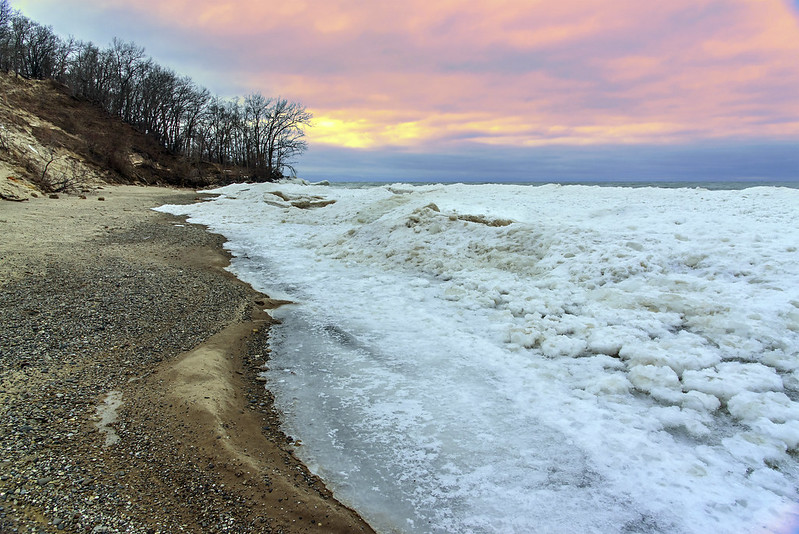 With the stroke of a pen, the President signed a bill yesterday, making The Indiana Dunes National Lakeshore America's 61st National Park. The Indiana Dunes National Park is Indiana's first national park. The 24 square mile park - created in 1966 - preserves miles of Lake Michigan shoreline, dunes, rivers, wetlands, savannas, and woods. The last few years have seen plenty of new land become part of the park. Many private homes on or near the dunes were left empty for years, and they were recently razed to become part of the national park. I'm not exactly sure what changes will take place now that it has become a national park, but additional parking, year-round washrooms, restored beaches (replenish lost sand), restore prairies and savannas to a natural state, and perhaps offer better access to the dunes that have been off limits for a few years.
With the stroke of a pen, the President signed a bill yesterday, making The Indiana Dunes National Lakeshore America's 61st National Park. The Indiana Dunes National Park is Indiana's first national park. The 24 square mile park - created in 1966 - preserves miles of Lake Michigan shoreline, dunes, rivers, wetlands, savannas, and woods. The last few years have seen plenty of new land become part of the park. Many private homes on or near the dunes were left empty for years, and they were recently razed to become part of the national park. I'm not exactly sure what changes will take place now that it has become a national park, but additional parking, year-round washrooms, restored beaches (replenish lost sand), restore prairies and savannas to a natural state, and perhaps offer better access to the dunes that have been off limits for a few years. 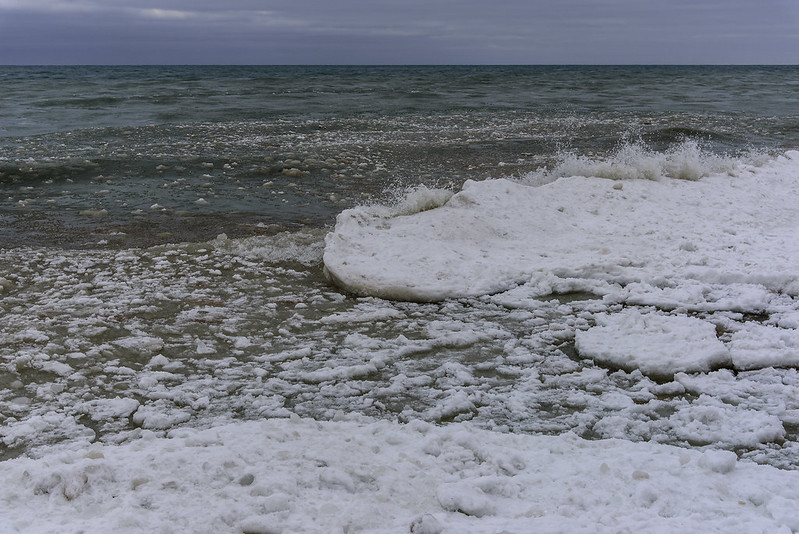 I visit the Indiana Dunes almost every weekend of the year - maybe 45 or so - and winter is one of the most interesting to me. Not only are there very few visitors, but the snow and ice formations along the shore can be incredible. This year, the shelf ice is relatively unimpressive, but if you've never seen mounds of ice such as these, it's still worth a trip. The ice on the lake is washed in by the waves where it's piled up piece by piece until the mounds freeze and slowly build out into the lake. This ice can build hundreds or thousands of feet off shore - virtually to the visible horizon. But remember, never venture onto this ice, it's not solid, and falling through is likely. Falling through this ice is usually a recovery mission for the Coast Guard, not a rescue. Congratulations to The Indiana Dunes National Park.
I visit the Indiana Dunes almost every weekend of the year - maybe 45 or so - and winter is one of the most interesting to me. Not only are there very few visitors, but the snow and ice formations along the shore can be incredible. This year, the shelf ice is relatively unimpressive, but if you've never seen mounds of ice such as these, it's still worth a trip. The ice on the lake is washed in by the waves where it's piled up piece by piece until the mounds freeze and slowly build out into the lake. This ice can build hundreds or thousands of feet off shore - virtually to the visible horizon. But remember, never venture onto this ice, it's not solid, and falling through is likely. Falling through this ice is usually a recovery mission for the Coast Guard, not a rescue. Congratulations to The Indiana Dunes National Park.
Dwarfed By Ice
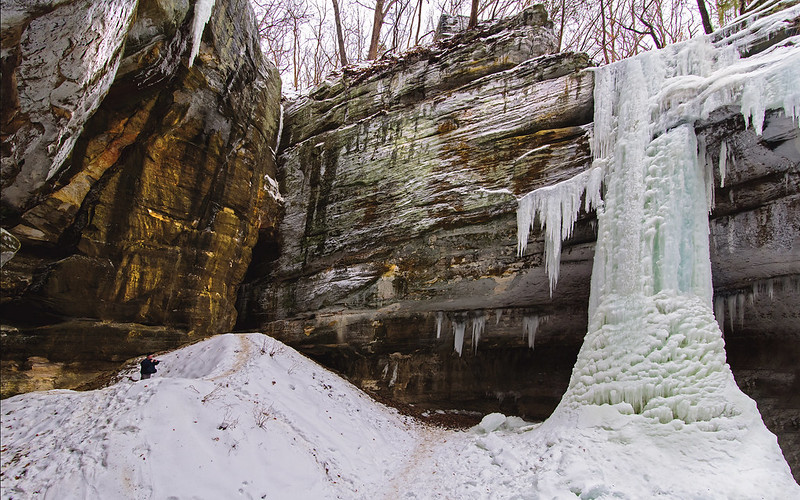
Another view of the main ice fall in Starved Rock's Tonti Canyon. The frozen waterfall and canyon walls dwarf all who enter the canyon, including Ken, a fellow photographer standing on the snow covered mounds of soil washed from above.
With continuing cold weather, this ice fall will grow wider and wider until the outermost icicles touch the ground. Once this happens, the ice is strong enough to support climbers. This is one of the ice falls in the part that is often attempted by ice climbers.
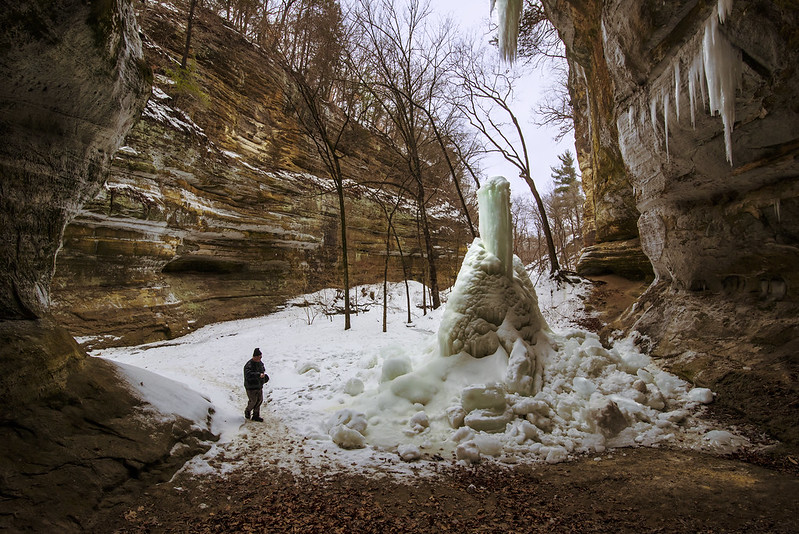
Just to my left as I captured the first image is the second waterfall of Tonti Canyon. It's generally a bit smaller, but still impressive. Once again, Ken is in the photo providing scale to the waterfall. If you notice, one of the large ice chunks fell from the top of the canyon and embedded itself into the ice mound on the canyon floor. These huge chunks can injure or kill visitors wandering beneath the ice falls.
Visitors should always be aware of the dangers above, especially during times of thawing. Not only can the ice fall from above, but loose rocks can also fall onto the canyon floor.
Owl Canyon Ice
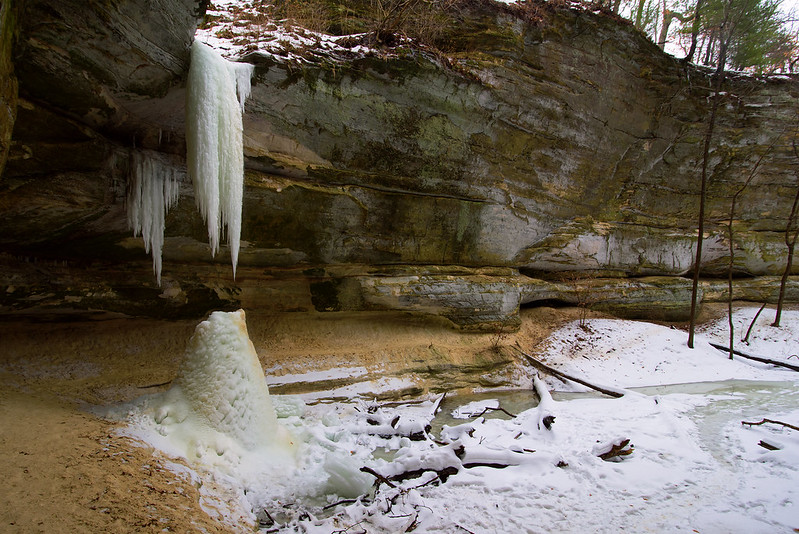
Owl Canyon is not often on my short list of canyons to visit while at Starved Rock State Park, but that may change. Over the years, I've forgotten about this relatively small canyon, and only passed over the top of it to hike to other more "interesting" canyons.
On this trip, I decided to take a quick look into the Owl Canyon while I waited for others to climb down the dozens of stairs. I was pleasantly surprised to see a rather large formation of ice clinging to the rim of the canyon.
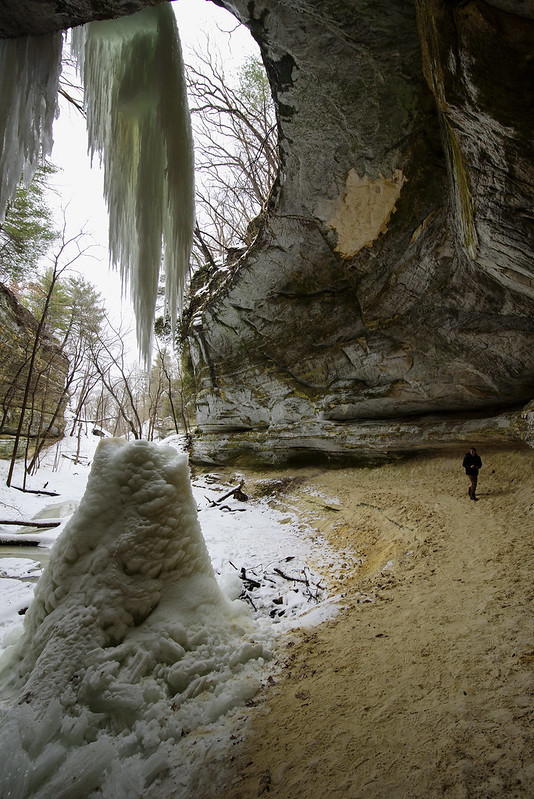
Only a few of the canyons here have ice formations that allow you to walk easily and completely behind them, and this is one of them. While the ice fall isn't wide and thin, creating an ice cave, it's still a unique perspective to view the ice "stalactite and stalagmite."
As a matter of fact, we visited this canyon twice that day, once on the way in and once on the way out. The second time, the canyon floor was filling up with water from the melting snow, making it a bit more difficult to reach the frozen waterfall, but not as difficult as some of the other canyons that afternoon. Some were impassible with rapid water flowing across the trails.
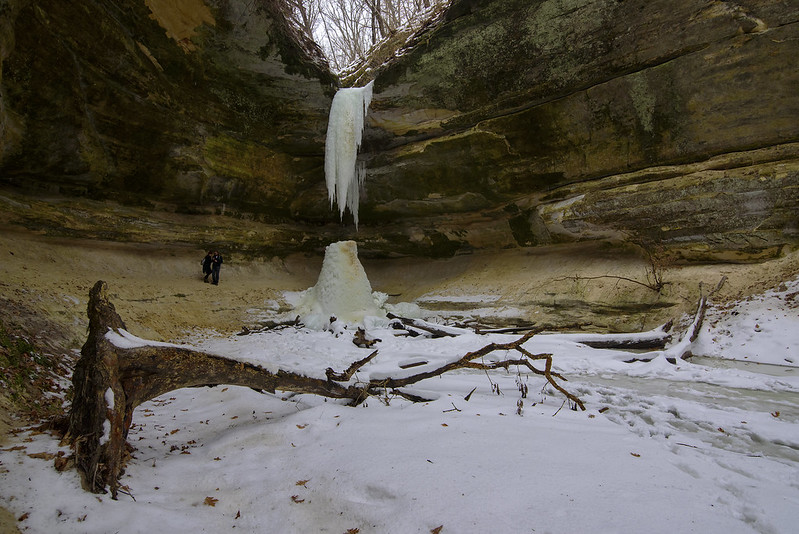
Snow on the Dunes

The weekend brought a little reprieve from the bitter cold weather, actually a big reprieve. An almost 70F degree rise in temperatures encouraged us to take a hike on the beach! The dunes along the beach to be exact. One of my favorite times to walk on the shore of Lake Michigan - it's like another world. The mounds of shelf ice extend hundreds of feet off shore, the snow covered dunes, and the lack of other people make winter a great time to wander the shore.
A hike through the woods to the ridge, then along the ridge to the nearest blowout brought us to this view. The coniferous trees stand out against the bright snow, and the drift ice is beginning to flow off shore, pushed by the winds from the south.
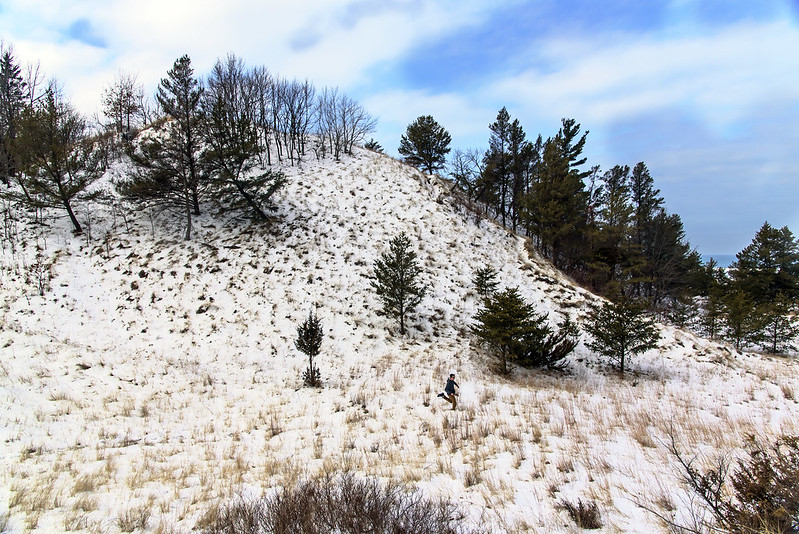
In several places, we were the first to walk through the snow-covered trails. While we are familiar with the trail, it's still difficult to see the narrow paths with several inches of snow on them. If you know what to look for, you can eventually begin to see the details that line the trail, and follow them.
Some of us had to run ahead to get to the beach faster, while others took their time.
Ice Spectacle

The ice formations in the canyons of Starved Rock State Park are ever changing. Each day with temperatures dropping or raising, the ice increases or decreases, builds and falls, creating new forms everyday. No matter what the weather, there always something new to see.
A 60 degree difference from just a few days prior, brought out scores of visitors to the state park. Many visitors were part of hiking clubs taking advantage of the 40 degree weather, while others were there strictly for the ice formations.
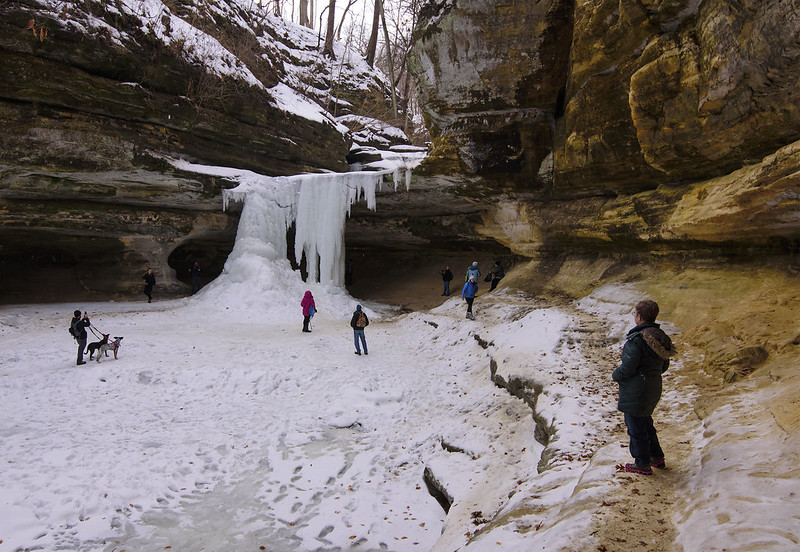
As Illinois' second most visited attraction (Navy Pier in Chicago is #1), I'm rarely alone in these canyons, but during last week's zero degree temperatures, we only saw a few people the entire day. In contrast, on this day we shared LaSalle canyon with dozens of people, each taking in the ice spectacle as they passed through.
Most of Starved Rock's canyons have some sort of waterfall - some have two, and they often remain frozen this time of year. During warm months, most waterfalls only flow after rains, so timing is crucial when trying to see them flowing. With the cold weather, even a slow drip eventually forms a huge frozen waterfall, so there is almost always something beautiful to see in winter.
Tonti Canyon in Winter

A 60 degree difference between last Wednesday and this Sunday allowed us to explore more of Starved Rock State Park's frozen waterfalls. Low temperatures of -24 F helped freeze the waterfalls solid in just a few days. Today's temperatures in the 40s began the melting process, but the cool canyons still retained most of their ice.
An unusual sight for me was the white frost on the walls of Tonti Canyon. I think it is due to the very cold temperatures a few days ago, then the warm temps yesterday and today. The warm air condensed on the cold canyon walls, and created frost. It certainly gave the canyons another layer of contrast.
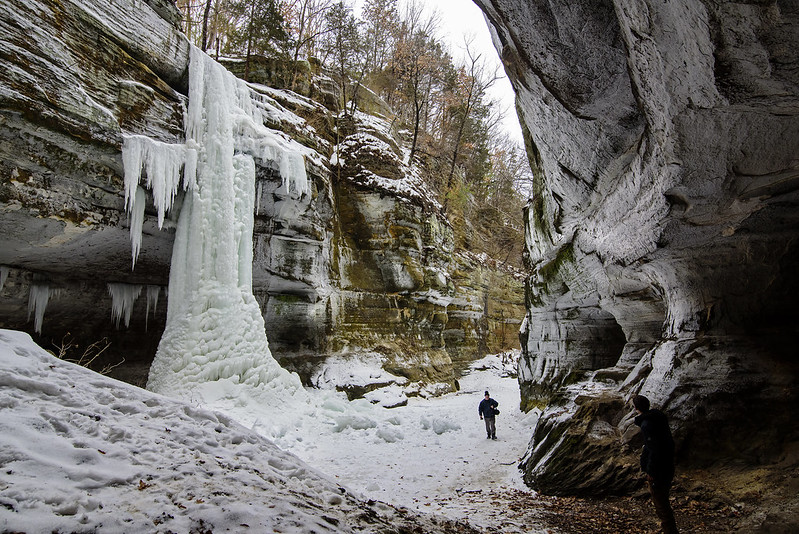
In just a week's time, the main waterfall in Tonti Canyon completely froze from top to bottom. Take a look at this post to see what the waterfall looked like last week. I'd estimate the height of the waterfall at around 60 feet, and if the cold comes back soon, this icefall will continue to build in thickness and perhaps allow ice climbers a chance at tackling the difficult climb to the top.
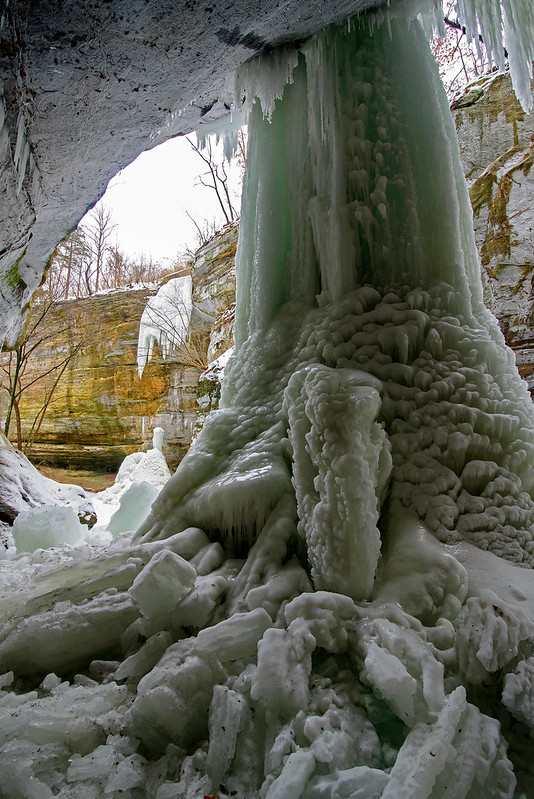
While being careful of the hanging icicles above, we wandered behind the icefall for a view of the backside. Unlike the thinner ice columns of LaSalle Canyon, this ice isn't as transparent, but it does offer a look at the beautiful details and patterns in the ice.
Looking closely to the left of the ice column, you can spot the second icefall of Tonti, a bit smaller, and not yet connected from top to bottom.
The Tonti Canyon bridge has been closed for quite some time, forcing visitors to take a 15 minute detour back through LaSalle Canyon. It's never a bad thing to visit this canyon twice in an afternoon, but the longer hike takes some time away from exploring other canyons along the way. I'm not sure what the State is waiting for - the bridge can be repaired for very little money, and very little time. Unless the bridge isn't the problem, perhaps it's the trail itself which seems a bit narrow just before the bridge. Either way, it's time something is done to improve a beautiful trail in Illinois' second largest attraction.
The Other Sister Waterfall
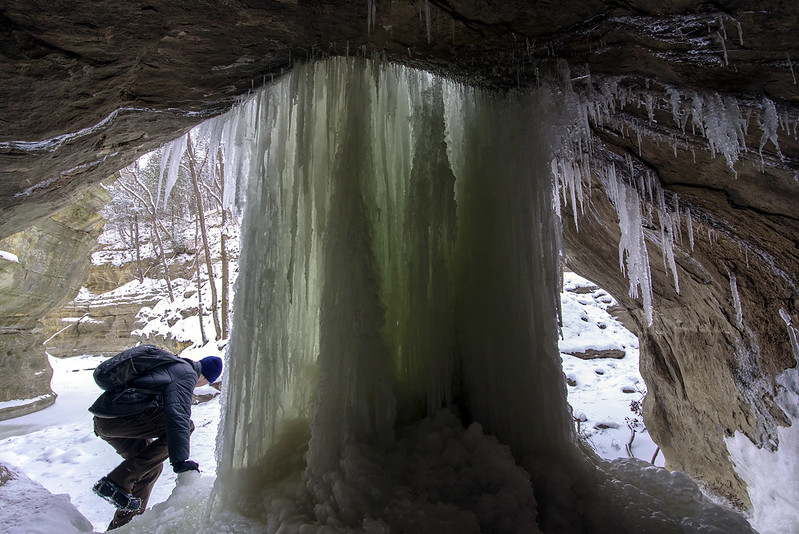
In the same canyon, and only a few meters away, this frozen waterfall is the second we visited and explored. This one is a bit taller, and the stone overhang is deeper, so it's quite a bit easier to get into to explore.
The ice here is a bit thicker than some of the other falls we saw, so the light doesn't penetrate through quite as much, but it still casts a nice color to the ice.
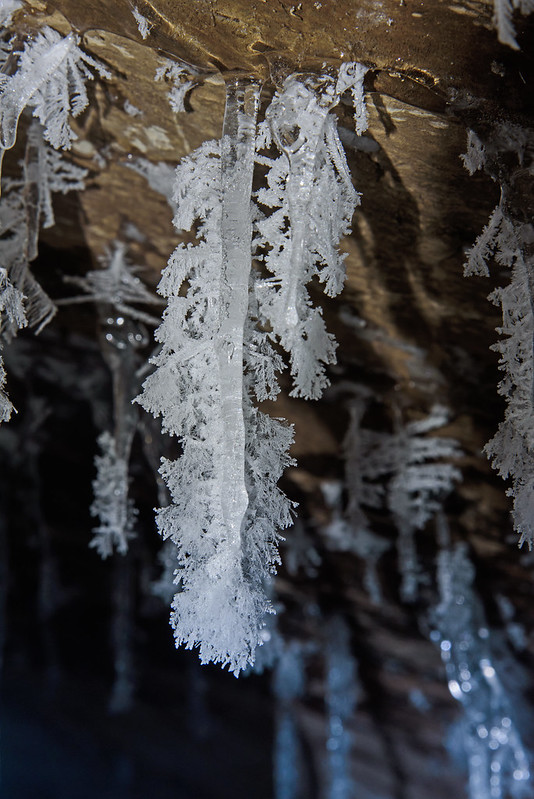
Inside the cave, the moist, cold air created some fancy ice formations. On the stone walls and on the icicles, feather ice formed. This is not too unusual for the empty spaces inside frozen waterfalls, but it very delicate and usually doesn't last long when visitors wander around.

The white icefall contrasts against the dark sandstone canyon walls. Visiting these canyons in the warmer months pays off, you get to know how deep the creeks is and where you can safely walk just in case the ice is thinner than you thought.
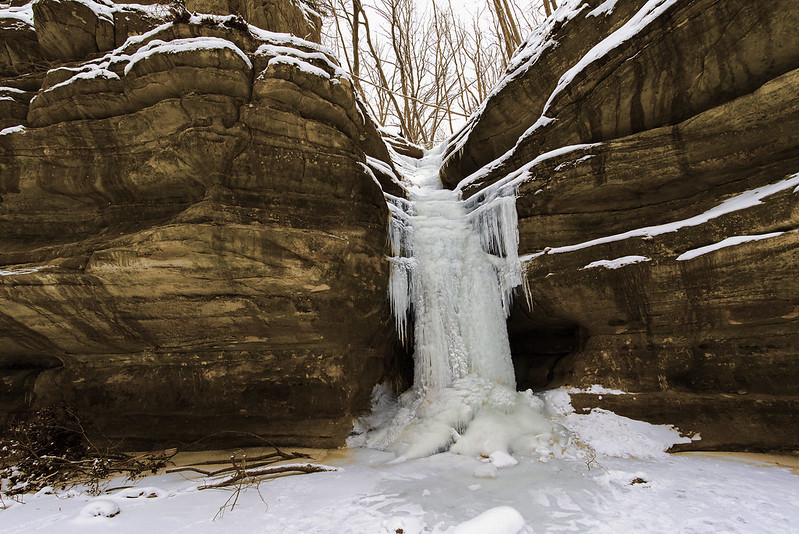
One of the Sister Waterfalls
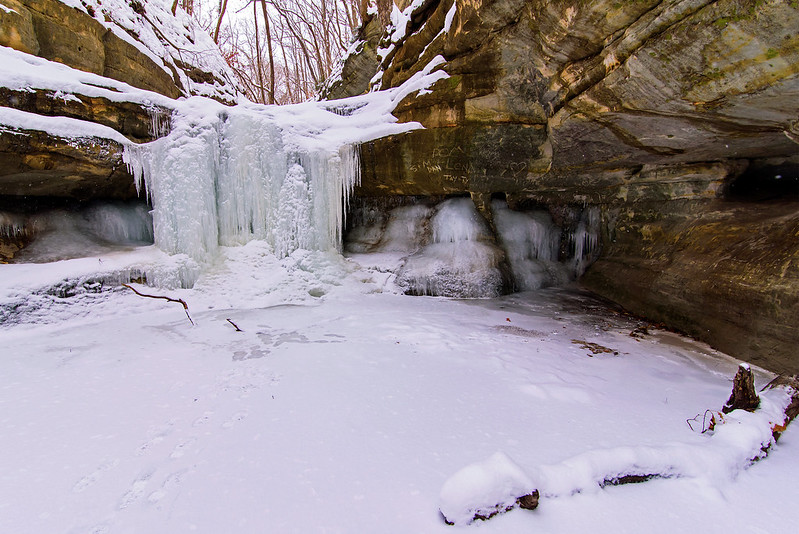
While hiking the upper dells of Matthiessen State Park, an area called Cedar Point marks a sharp turn in the canyon floor. Hidden from view are two waterfalls relatively close to each other, that many people overlook. If you're willing to cross the creek, you will easily discover these waterfalls, but so many hikers don't bother.
In winter, these slow waterfalls create ice falls that are always impressive. The ice is generally such that the backside of both waterfalls is accessible, creating ice caves between the ice and the stone overhang.
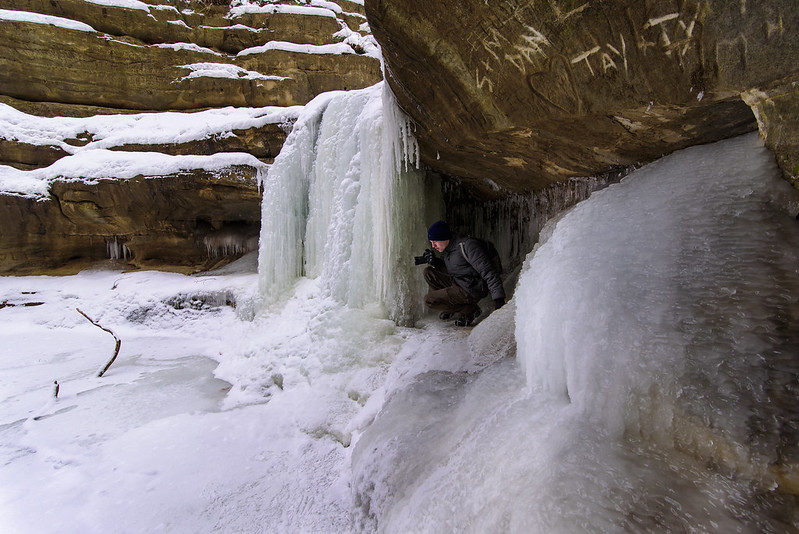
With a bit of climbing on the slippery canyon floor, you can get into the ice cave and see an unusual environment. The soft light illuminates the interior of the cave, and also shines through the translucent ice.
Once inside you can see exactly how the water flows over the canyon walls. Frozen, the water seems as though it flows with a turbulence at high speed, but in fact, in merely trickles down and builds up over time.
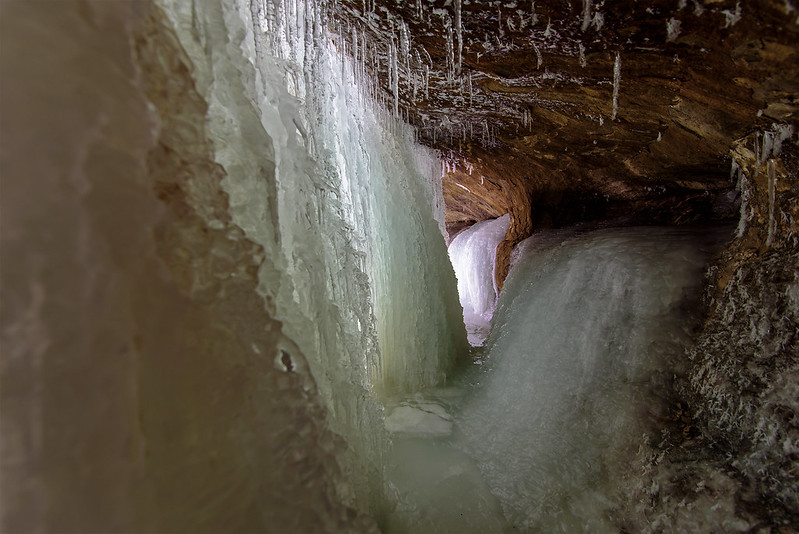
If you feel like exploring these ice falls, remember to dress warm, wear ice cleats to prevent falling, and prepare to get wet. These ice falls are still flowing with water - sometimes on the inside of the ice, sometimes over the outside, but either way, you'll get wet or soaked. The floor of the ice cave is usually soft ice with water three or four inches deep.
If you get wet, you have a long, cold walk to the parking lot.
Tonty Canyon's Icefall Progress
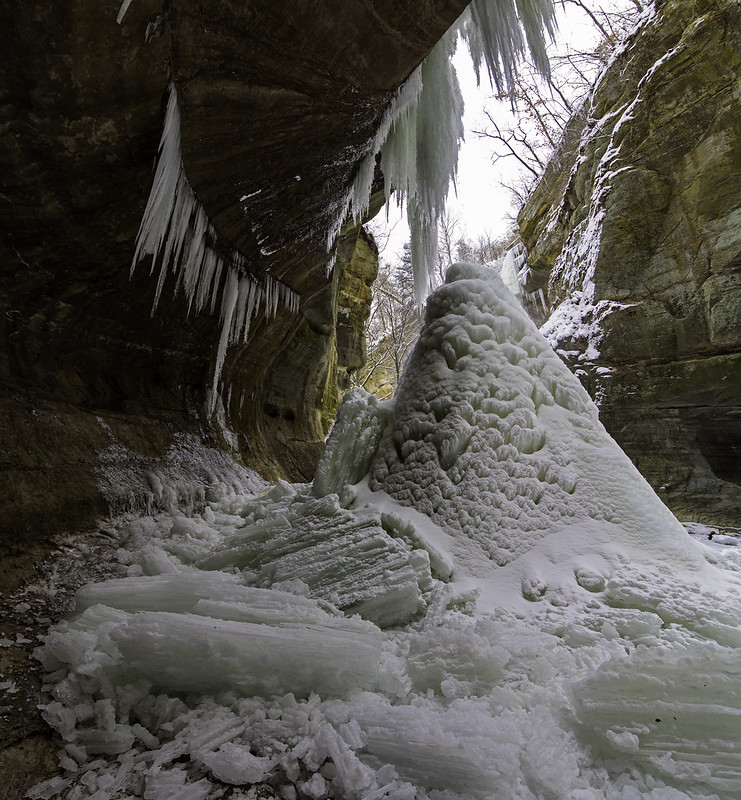
A close neighbor to LaSalle Canyon is Tonty Canyon, only about a quarter mile or so away. Tonty boasts two waterfalls, and in winter, two icefalls. The main icefall is coming along nicely, but not as large as some of the other canyons at the park. The water is flowing quite a bit, so with the forecast of bitter cold weather, there's little doubt these falls will be much larger in the next few days.
In a few weeks time, these falls should be large and strong enough to climb. I've noticed that Tonty Canyon's icefall is one of the more delicate looking, with a lot of intricate details. This must be due to the rock's shape overhead, forcing the water to follow a meandering path down to the ground.
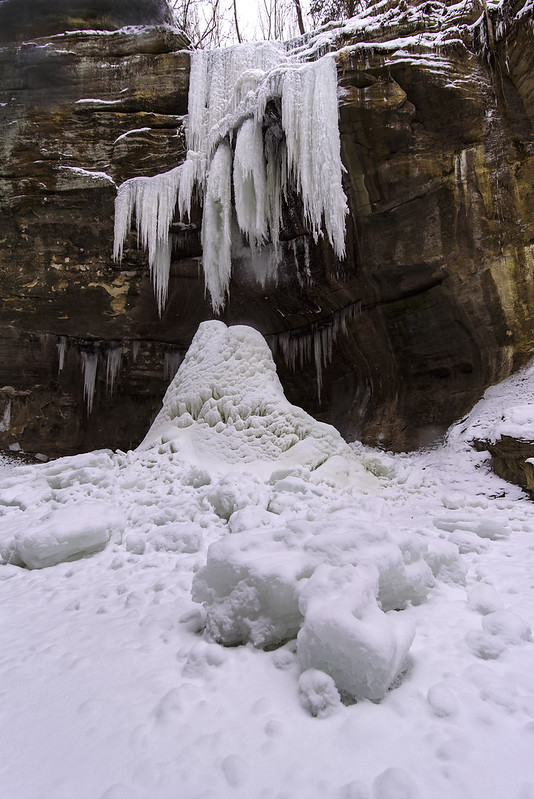
You can see the ice columns forming at the top of the falls, in the shape of tubes. The water will continue to flow through the inside of the ice columns all winter long. I'd estimate this fall to be 40 to 50 feet in height.
The LaSalle Canyon Icefalls
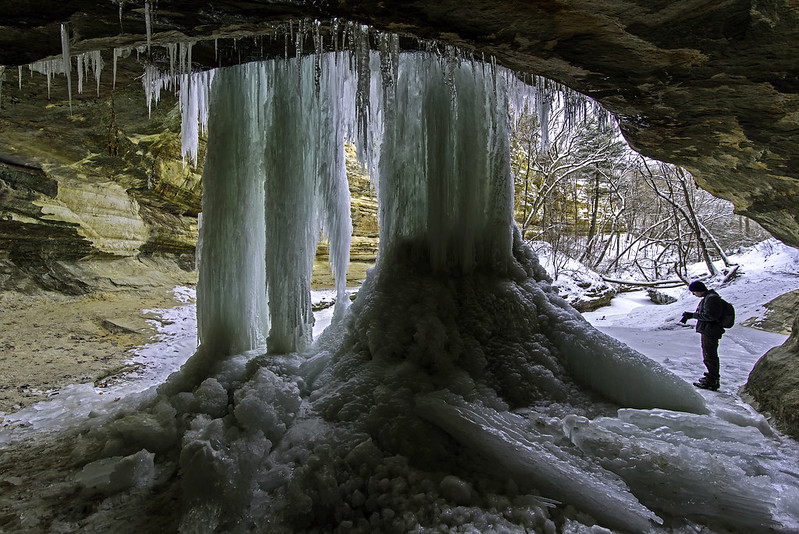
One of the most popular places to visit in Illinois is Starved Rock State Park. While most people visit in the warmer weather, or make a quick visit in February to view the large number of eagles on the Illinois River, I enjoy the cold winter months. Most of the canyons of Starved Rock have waterfalls at some point in the year, and most create stunning icefalls in the cold months.
The waterfalls range from ten feet tall to well over 70 feet tall, and some can even be climbed with the proper gear and permission. A small number of these frozen waterfalls allow for viewing on all sides, and the waterfall in LaSalle Canyon is one of the easiest to access.
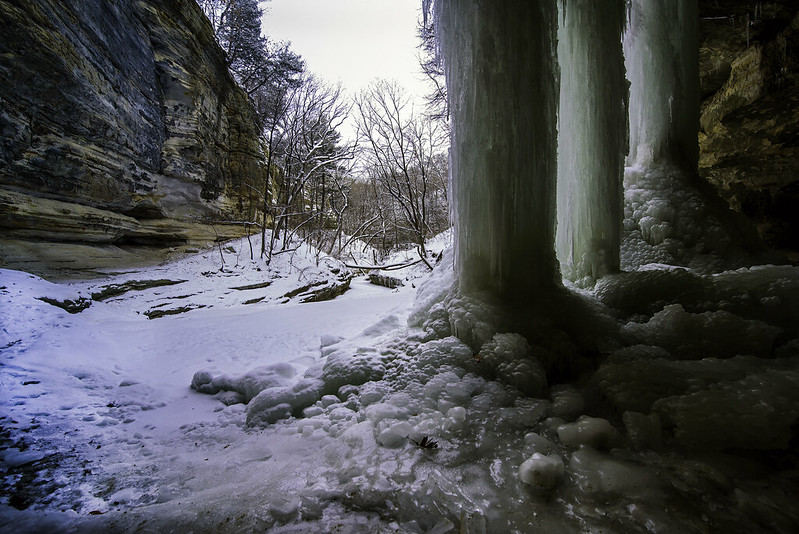
While not the closest canyon to a parking area - it's a mile hike or more to the waterfall, the trail leads behind the waterfall, giving you a unique perspective of the frozen falls in relation to the canyon. The sun shines through the large towers of ice, illuminating the backside with beautifully eerie light.
The size of the rock overhang also makes it very easy to walk behind. Some other waterfalls are so close to the canyon wall you must crawl behind. The only tricky part can be the ice on the canyon floor. In some places the slanted rock is glazed with thick ice from the waterfall, so ice cleats are a necessity. Last year as I hiked behind a couple of people, one slipped and fell down the side of the path. She held onto a small tree trunk, which prevented her from falling down the 30 foot drop to the canyon floor. Her hiking partner and I quickly pulled her back to safety. I won't hike this area without ice cleats - not the little yak tracks with the springs or studs on the bottom, only chain and spike ice cleats that dig into the ice.
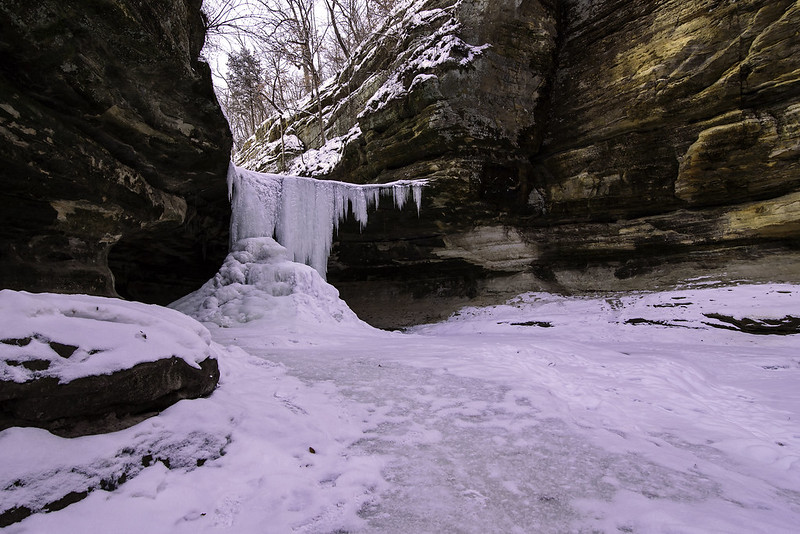
This canyon has two waterfalls, the main waterfall seen here, and a much smaller one draining into the creek which drains into the Illinois River a few thousand feet away. LaSalle Canyon is a must see in the winter. It also serves as the path the Tonti Canyon, which often has two tall waterfalls in the cold winter months.
Subscribe to:
Comments (Atom)

